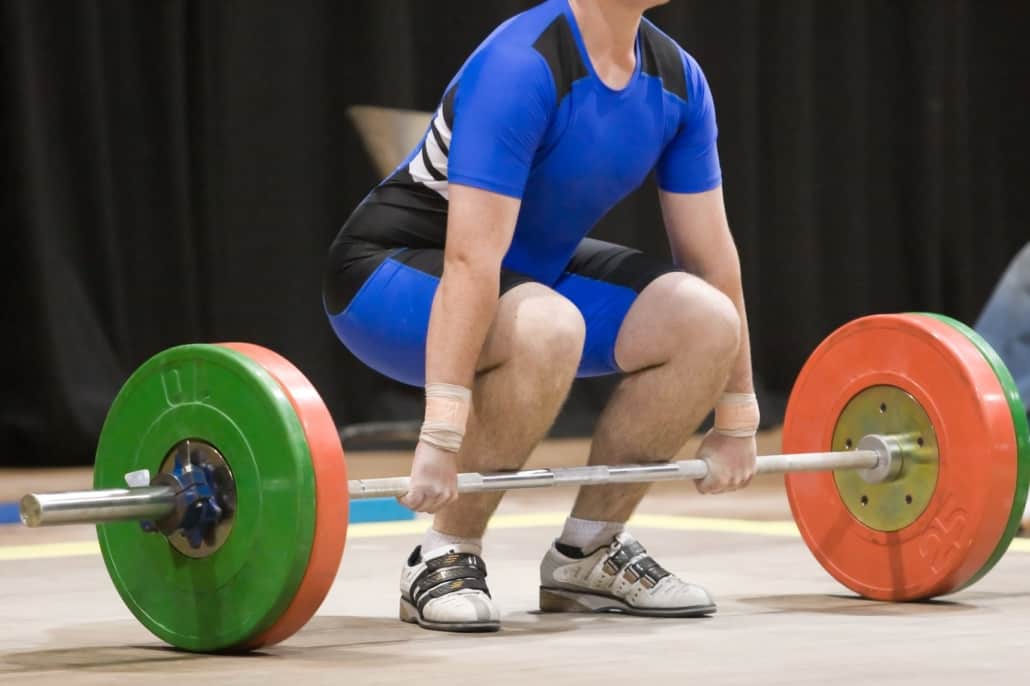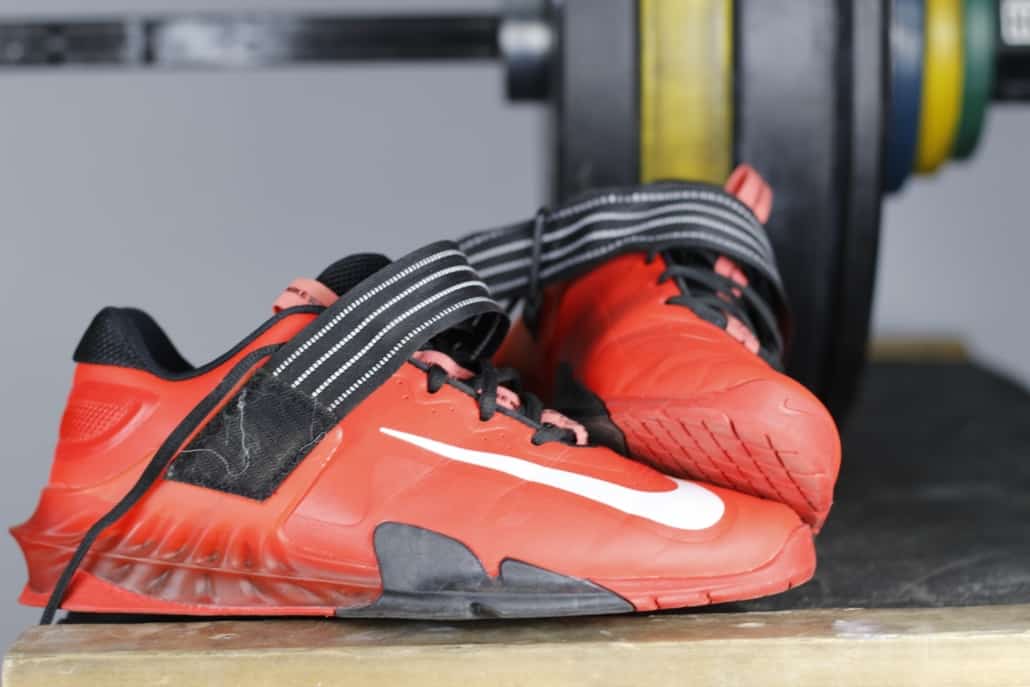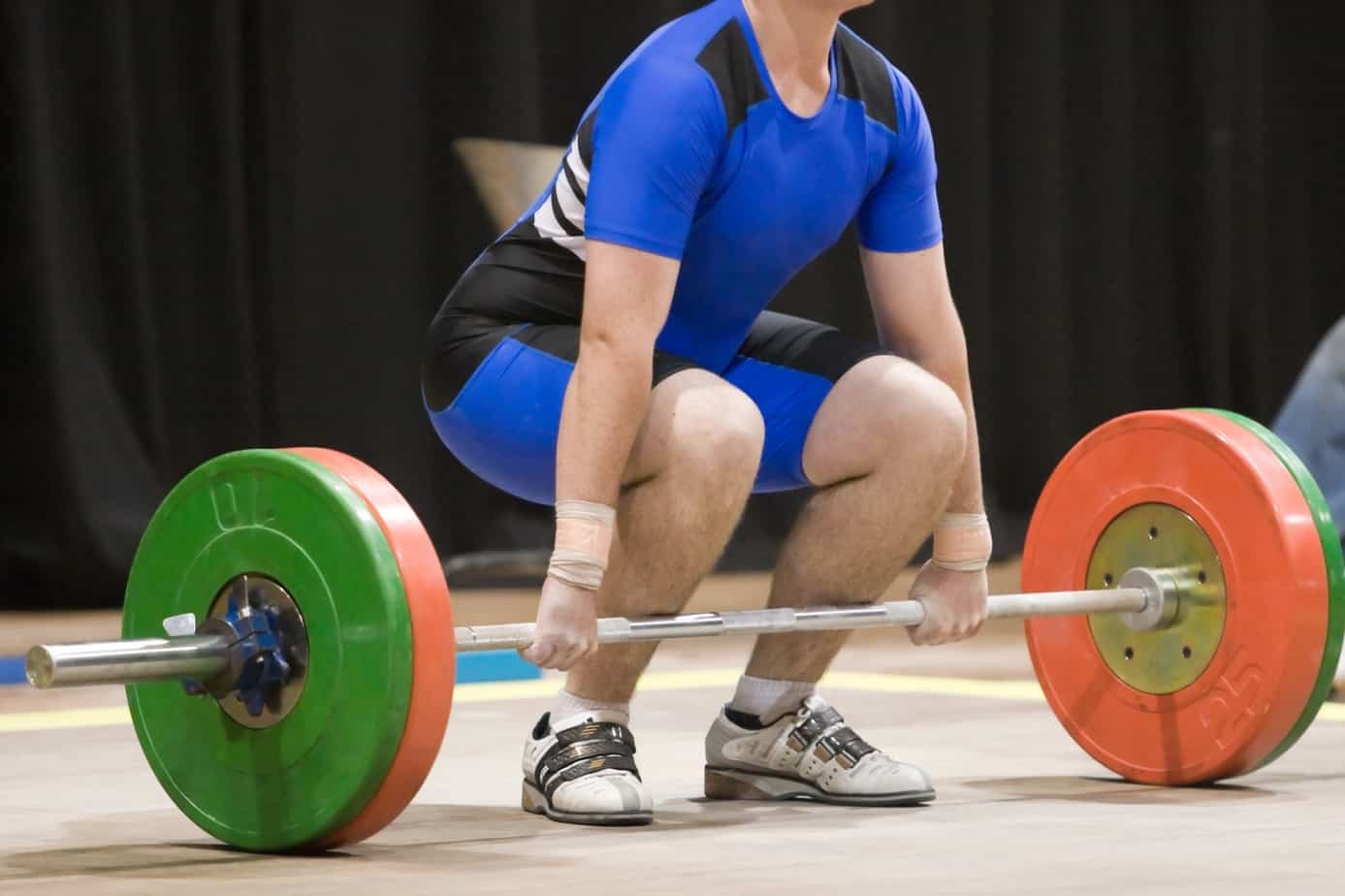Are specialised weightlifting shoes essential? And what about bare feet?
Many gym-goers wear trainers or sneakers, but some wear special weightlifting shoes with a built-up heel. And some may have no shoes at all. What is this witchcraft?
What are weightlifting shoes?
There is generally somewhat of a timeline you work through when you first join a gym. You’ve likely found yourself there in the first place as you want to make some kind of a change – you want to be healthier, fitter, stronger … the list goes on. So, you enter.
For many, that timeline begins with the use of cardio equipment or some weight machines. They’re relatively simple to navigate and you may have even used them before. From there, you may catch a glimpse of the free weights section. You may have been told of the benefits or simply have a desire to go over there and give it a shot. And you should, it’s awesome – but that’s for a different blog. This blog will discuss one of the things you might see when you get there.
Often, you’ll see plenty of accessories on the inhabitants of the free weights section that you may not have seen before. Some lifters may have weightlifting belts, or even belts where you add weight to make pull-ups or dips more taxing. You may see chains hanging from the ends of the bars, or straps around the lifters’ wrists to strengthen their grip. But that really is just the start.
Today, we’re going to discuss what happens south of the ankle. What do these guys and girls have on their feet? Some will have the same as you, likely trainers or sneakers. But some may have special weightlifting shoes with a built-up heel. And some may have no shoes at all. What is this witchcraft? Is this the secret of the weights room that’s been shielded from the cross trainers and rowing machines for so long?
Well, we are going to have a look through the science to help us understand the pros and cons of these approaches and figure out which might be the best one for you to get the most out of your sessions.

A brief weightlifting intro
Allow me first to address something that I’m a bit of a stickler for. Weightlifting and weight lifting are different. Weightlifting is what you see in the Olympic Games. It’s the snatch and the clean and jerk. Weight lifting is anything where you pick something heavy up for some kind of athletic reason, often in the gym – confusingly, this can also include weightlifting! The reason for this pedantry is to clarify what I’m talking about throughout the rest of this blog.
What do weightlifting shoes do?
Firstly, it’s important to point out that no non-weightlifter needs weightlifting shoes. If they aren’t in your budget right now, then don’t worry – you can still master solid techniques without them. In fact, some coaches actually recommend not using them at first, so you don’t become overly reliant on their benefits. But what are those benefits and why do people wear weightlifting shoes?
We mentioned earlier that weightlifting shoes have a built-up heel – this is the secret to their benefit. If you’ve ever performed a squat, you may have struggled to get as low as you were aiming. This is often a result of having poor mobility at the ankle. It’s something that can be improved over time but certainly isn’t something that will change overnight. A raised heel helps with this by increasing the tibial (shin) angle, meaning that for the same bend at the ankle, you’re able to get down lower. In fact, when wearing weightlifting shoes, you actually bend your ankle less and compensate by bending more at the knee and hip than when wearing normal trainers.
This can also lead to helping more experienced lifters to maintain a more upright torso during some lifts – something that can be really advantageous as it keeps the centre of mass towards the middle of our base of support (basically, directly above and in the middle of our feet). This is especially important as the load increases because it prevents us from losing balance and dropping the weight in front or behind us. It also makes the lift a little easier too.
These changes in position are not to come at the expense of improved mobility and technique, though. In fact, this trunk position benefit has not been shown in less trained back squatters wearing weightlifting shoes. However, considering all we’ve discussed, it seems weightlifting shoes would be advantageous in either of the Olympic lifts as well as other similar movements, including squat and leg press variants.
Beyond the change in shin angle provided by the heel, the wedge itself is very firm. So, unlike a cushioned trainer, when you push down hard during a lift, none of that force is absorbed into the shoe. This is really effective when you get to your heavier loads as you can utilise all produced force in the lift and not lose any through the compression of your shoe heel. It’s the same principle that led to some very quick sprint times at the recent Olympics. In Tokyo, it was the track track that was firm, meaning all force the athletes produced was rebounded back by the springy soles of their shoes, keeping them moving quickly.
Having said that, it’s important to highlight that weightlifting shoes are not essential. Similarly, it’s also important to point out that you don’t need to be an advanced lifter to want to own a pair either. If you’re enjoying lifting and would like some of the benefits, then go for it.
What about lifting barefoot?
We mentioned at the start of this blog that you may have spotted some people lifting in the gym with no shoes on at all. That seems fairly counter-intuitive, keeping in mind what we’ve just said about the benefits of a weightlifting shoe. However, again, this is all about putting you into a better position during the exercise you’re doing. If you’re deadlifting for example, you don’t want to be too far from the floor (as you would be with an elevated heel) because it’d be much harder to get low enough to pick the weight up. In this case, you want to be as low as possible, so you have to move the weight over as small a distance as possible.
This is why many opt for barefoot lifting or wearing very thin-soled shoes, like Converse. Beyond these positional benefits of lifting barefoot, some also suggest it can lead to greater increases in strength. This may be a result of having to work harder when lifting like this, as it requires you to constantly stabilise yourself (a job typically made easier by your shoes), which may be beneficial depending on your goals.
As hopefully you know by now, these blogs are based around science, so let’s have a quick skim around the research to see how that influences our decisions around barefoot lifting. It does indeed appear there are benefits to deadlifting barefoot for the reasons previously stated. The need to lift weight over a greater distance when wearing shoes does lead to an increased force requirement, whereas lifting barefoot makes shifting the same load easier by decreasing that distance, hence, the force required. Having said that, these small differences are likely only of value when lifters are very close to their personal bests. Interestingly, some individuals also prefer squatting barefoot despite the evidence above for a heel raise helping such movements. This may be a preference of some, but it seems that there is no biomechanical advantage obtained in doing so.
While we’re on barefoot lifting, it’s worth a quick public safety announcement to say to be careful when doing so – accidents in the gym do happen!
Some other options
If you’re interested in weightlifting shoes and their benefits but aren’t totally sure about buying some just yet, you might be wondering whether there are any other other options. Well, one quick fix is to use an external wedge under your heel to bring about some of the same advantages. You may have seen this in the gym too, and not really know why people were doing it. The easiest way is to use a small (1.25 or 2.5kg) weight plate under each heel. This has been shown to provide a beneficial position, especially if you’re new to moves such as squatting. This gives the benefit of a more advantageous ankle position before you’ve acquired your new pair of shoes.

How should weightlifting shoes fit?
If you are interested in purchasing a pair of weightlifting shoes, then ideally, you want to try some out to see how they fit and feel. Brands such as Nike, Inov-8, Risto, Reebok, and Adidas are good places to start. A good retailer will let you try them on and even go through a few unweighted moves to give you the best chance of bagging a pair that feels comfortable and works for you.
Take homes
Weightlifting shoes can offer a real benefit in some of the big lifts in the gym. They can also help if you have mobility issues, though shouldn’t be used at the expense of working on any mobility deficiencies. You shouldn’t feel limited without them or compelled to get a pair, though. Plenty of exercises are not aided by them, and there are even alternatives, such as using an external heel raise if you’d prefer. Barefoot lifting also has some benefits – just be careful not to drop anything on your feet!
If you are interested in investing in a pair, it is best to try on a few different brands to see how well they fit you and how they feel when you go through the key movements. If you do end up wearing a pair in your local gym, just remember one thing: It doesn’t mean you no longer have to re-rack your weights, no matter what anyone tells you!
[optin-monster slug=”nhpxak0baeqvjdeila6a”]




